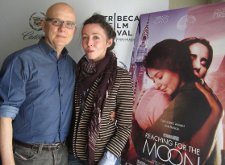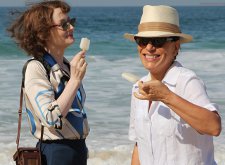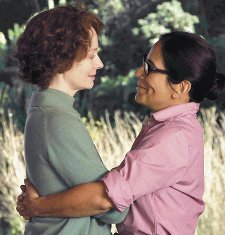 |
| Bruno Barreto's Reaching For The Moon |
In Reaching For The Moon, Bruno Barreto navigates handsomely the love story between the Pulitzer prize-winning American poet Elizabeth Bishop and the Brazilian architect Lota de Macedo Soares, who designed Flamengo Park in Rio de Janeiro, making a Central Park out of a landfill with street lamps that recreate the moonlight.
In my conversation with Barreto on his poetic film, we discussed how Deborah Kerr, co-starring with Cary Grant in Leo McCarey's An Affair to Remember, is channeled by Miranda Otto and how Sydney Pollack's Out Of Africa made for the perfect pitch, even without Meryl Streep or Robert Redford. Barreto explained that Jane Campion's Bright Star on Keats and Christine Jeffs's Sylvia on Plath were not the way to go in the portrayal of Elizabeth Bishop and why Stephen Daldry's The Hours has the right intricacy.
Anne-Katrin Titze: You had your premiere of Reaching for the Moon at the Tribeca Film Festival?
Bruno Barreto: Tribeca was the [North] American premiere, the very first screening in the US, which is the core audience because it is an English-spoken film. It was very good, the audience was right there with the film. In Berlin, which was the world premiere, it was overwhelming. There were 1200 people, it was a huge theatre, they went nuts, they clapped for exactly ten minutes. I timed it.

The extraordinary yarn begins at the Boat Pond in New York's Central Park, on a bench, where Bishop suffers "weekly attacks" on her poetry and her virtue by good friend Cal (Treat Williams), none other than poet Robert Lowell, who suggests the vacation to Brazil.
AKT: Did you visit the Boat Pond in Central Park before the screening here in New York?
BB: The Boat Pond? Not this time, yet.
AKT: Will you go?
BB: Maybe I should! And do like they do in Rome and maybe throw a coin.
AKT: When was your first encounter with Elizabeth Bishop's poetry?
BB: My mother, the producer Lucy Barreto, bought the rights of this book, the first book written about this story in 1995. And she came to me and asked me, you know, told me the story, and I wasn't interested. She then offered it to Héctor Babenco, who did Kiss Of The Spider Woman (1985) and it didn't pique his interest either. He didn't read it, she told him the story. Almost ten years later, 2004, my ex-wife, the actress Amy Irving, decided to do a monologue about Elizabeth Bishop, called A Safe Harbor For Elizabeth, which had been written by a Brazilian playwright [Marta Góes, who grew up in Brazil]. That was initially at the Powerhouse Theatre up in Vassar where Elizabeth went to school.
AKT: And Mary Morse.
BB: And also Mary McCarthy and some of her colleagues. When I saw that, that's when I started to feel the itch. Then I went to read the book that my mother had bought the rights for. Then I went to read the poetry. This was all very interesting but why do I want to tell the story? What is the angle? The fact that she lived in Brazil is not enough. What was she really about? What was the essence of this relationship with Lota? That's when I decided I want to tell the story to talk about loss and how loss is so crucial in anybody's life.
AKT: You picked her poem about the "art of losing" as a core to the structure of your film?
BB: Not her main, but one of her most famous poems, although she is very unknown, was One Art, which starts with "The art of losing." That's why the film was called for a long time The Art Of Losing. I lost, because I couldn't convince the distributors.
AKT: People don't want losing in the title. And there are a lot of moons in her poetry as well.
BB: There are a lot of moons in the film as well. I like Reaching For The Moon. I think The Art Of Losing was a little too much on the nose.
AKT: You chose imagery from the different poems and wove them into new visuals. For example, from her poem The Shampoo, you have the women washing each other's hair twice and you use the cauldron in a completely different context with children playing. Were you making your own poems?
Glória Pires as Lota gives a performance full of energy and delight.
BB: Right. This was not pursued in a very obsessive way. I said to myself, the last thing I want to do is another film about a tortured artist or tortured poet. Of course, I had seen Sylvia about Sylvia Plath [2003] and Jane Campion's beautiful but redundant film about John Keats [Bright Star, 2009]. Films about artists are very boring. I wanted her to just be a character in my movie. The film is not about her, it's not about Lota - the film is a love story and they happen to be the main characters. The connections [to the poems] were unconscious and then we would realise it had happened.
The shimmering eyes of dozens of owls punctuate the dark jungly forest, while the two contrasting souls drive towards their first kiss. Reaching For The Moon has the scope of Out Of Africa and "Brazil is not for beginners," as Bishop will later conclude.

AKT: That's probably why the connections feel so natural. I never had the feeling that you were illustrating a poem, which is often awful. You sprinkle in some owls and different shades of green.
BB: The owls came actually from a story the real Clara told, the daughter, who is still alive.
AKT: Has she seen your movie?
BB: No, because I just finished it now. After Berlin, I took out five minutes. It hasn't been shown in Brazil, yet.
AKT: What happened during the five minutes you cut?
BB: Nothing. It was a cab scene when she comes to New York. The cab scene was about awkwardness and when she comes to the apartment it's about awkwardness, as well. That's why I took it out. Even though it was good, I had to take it out. First they are quiet, then, Lota says: "I didn't sleep on the plane. There was a baby crying," and Bishop says "there's always a baby." Then Lota says "how is teaching?" and Bishop says "it's going well. Sometimes I do it sober!"
AKT: I think this is her saving grace, that she can be honest about her alcoholism. She is not a lying drunk.
BB: "I don't drink because things go wrong. I want to drink every minute of every day."
AKT: Bishop's trip to Brazil on the ship, although it's very short, reminded me visually of Leo McCarey's An Affair To Remember (1957).
BB: I'm glad you're saying that. I love that film.
AKT: There's a bit of Deborah Kerr in Miranda Otto's beautiful performance.
BB: Absolutely. I wasn't aware, but this is all coming back now. You are right, absolutely right.
AKT: You had a great costume designer. The nuances in colour for the three women are remarkable. How did you work together?
BB: The costume designer was wonderful. I had never worked with him [Marcelo Pies] before. The original costume designer couldn't do the film, she worked with me on Four days in September and Bossa Nova and actually I gave her credit as associate producer, Emilia Duncan. Amy, my ex-wife called her "my Edith Head". Very wise, we spent like a month with her and the costume designer and the art director. She was like a consultant for art direction and costume design, conceptualizing - that's how we could be so specific.
AKT: The [Alexander] Calder pin? Did Lota, in reality, give it to Bishop?
BB: Yes, that is real, that is true. For me, fashion is very much behaviour. In filmmaking, for me, much more important than good lines are good behaviours. That's the hardest thing to achieve, you don't write behaviours in front of a computer screen. You discover behaviour with your actors. I was exhausted. I never made a film that made me so tired, and this is my 19th feature film. Because I had two intelligent women, no three - there's also Mary played by Tracy Middendorf - ask me questions 24 hours a day. We were all staying at the same hotel when we were shooting in that house, which is half of the film.
AKT: That fantastic house, is that the actual house where Lota lived?
BB: No, that's not the real house. The real house is still there, but the woman who owns it wouldn't even allow us to go in and see what it looked like.
AKT: The house you use in the film is an Oscar Niemeyer.

BB: Yes, it's very similar in style. It is an Oscar Niemeyer. The real one is a Sérgio Bernardes, who is not as known as Niemeyer. But the essence is the same - a very daring modernistic house set against the jungle. The studio [for Bishop to write in] we built on a plateau. That was not there. To me the film is very stylish and yet, how not allow that to stand in front of the story and the emotion? My biggest challenge was - I wanted to tell this story in a very emotional way but they were people that were very into style and form - they were two intellectuals in their own way. And how do I convey their deep emotions? I found it very emotional but not in an explicit way.
AKT: It has to do with the house and the style. This is part of who they are - how can you separate that from the way they behave with each other? It's part of how they communicated and read each other. The twin sets, for example, signal "New England comes to Brazil," doubled with the dialogue, that's where you get the attraction.
BB: Very much so. I think you are right. Being instigated by intelligent questions - that's where I discover the film I made.
AKT: Breakfast scenes are important in your movie. I hope you are not too hungry to talk about them? [When Barreto arrived for the interview, he mentioned that he was starving and ordered food, which had yet to show up].
BB: You know, breakfast is very important for Americans, for us Brazilians, lunch and dinner are much more important. But Lota in many ways was even more American than Bishop in the sense that she was this doer and very practical. She was like the epitome of the winner and pro-active.
AKT: And she tells everyone so. This is where the verbal communication is working really well. She says "I'm the best - I was born an architect!" Who talks that way? Who is so convinced of their greatness?
BB: Yeah. Who is that self-confident? Mary asks that later. Of course it's brittle. There was something brittle in Lota, that's why she collapsed.
AKT: Then politics creeps into the picture, right-wing politics which will surprise audiences. There are these nice people having parties and suddenly there's the world.
BB: There's the world - exactly. For me one of the most important moments of the film or rather, one of the most original instigating moments of the film is the speech that Elizabeth gives when she gets the National Book Award. She starts to talk about Brazil in a very accurate way. It is bitter, but it's not. It's sharp and it's such an X-ray of Brazilian culture - its urge to celebrate and yet, the melancholy, the abandonment.
AKT: I saw the Gore Vidal film [Nicholas Wrathall's The United States Of Amnesia] yesterday, and there is a great scene in which he describes his relationship to John F Kennedy, whom he loved as a person and whom he considered one of the worst presidents. Vidal continues to explain that he has JFK's photo by his desk, not because he admired him so much, but as a reminder never to be tricked by charm again. There's something of that corruptibility in Bishop's speech.
BB: That's wonderful. The traps of charm and seduction. I think Kennedy was very much trapped in how seductive he could be.
AKT: "I did it because I could." That is the fascination with power that you don't even listen any more.
BB: In many ways, you know, that's the trap for us artists as well. It's the trap of seduction because to be an artist is to seduce. That's why you should never believe in your own press. [He laughs a hearty laugh].
AKT: In my review I compared your film to Out of Africa [1985].
BB: I'm so glad to hear that. I always defined that film - I'm sorry this is a very Hollywood way, but I had to sell it to people: if I succeed, I want this film to have the complexity of The Hours [2002] and the emotion and epic scale of Out Of Africa. I always saw it that way.
Bruno Barreto's Reaching For The Moon is the beautiful result of a filmmaker inspired by the exceptional poetry of distinctly visual writer Elizabeth Bishop and Miranda Otto's performance is translucent and captivating.
Reaching For The Moon is out on DVD in the UK now and On Demand, you can order it from Amazon here.





















